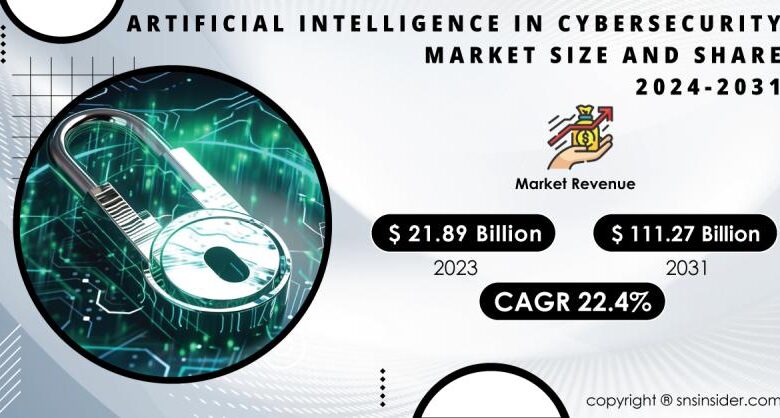Artificial Intelligence in Cybersecurity Thrives as

Artificial Intelligence in Cybersecurity Market Scope and Overview
Artificial Intelligence (AI) has emerged as a game-changer in the cybersecurity landscape, revolutionizing the way organizations detect, prevent, and respond to cyber threats. By harnessing the power of AI algorithms, machine learning, and advanced analytics, cybersecurity solutions can proactively identify and mitigate security risks, protect sensitive data, and safeguard digital assets from evolving cyber threats. In this report, we delve into the Artificial Intelligence in Cybersecurity Market, exploring its competitive landscape, market segmentation, regional outlook, key growth drivers, strengths, impact of the recession, etc.
Get a Report Sample of Artificial Intelligence in Cybersecurity Market @ https://www.snsinsider.com/sample-request/1993
Competitive Analysis
The Artificial Intelligence in Cybersecurity Market is characterized by intense competition and a diverse array of players offering innovative AI-powered security solutions.
Major Key Players in the Market are:
➤ NVIDIA Corporation
➤ Intel Corporation
➤ Xilinx
➤ Samsung Electronics
➤ Micron Technology
➤ IBM Corporation
➤ Amazon Web Services
➤ Darktrace
➤ Cylance
➤ Vectra AI
➤ Others
These companies leverage AI technologies such as machine learning, natural language processing, and context-aware computing to develop cutting-edge cybersecurity solutions that effectively detect, analyze, and respond to cyber threats in real-time.
Market Segmentation
➤ On The Basis of Component:
The market segmentation based on components includes software, services, and hardware. Software solutions form the core of AI-driven cybersecurity platforms, offering features such as threat detection, incident response, and security analytics. Services encompass a range of offerings including consulting, implementation, training, support, and managed security services. Hardware components such as AI accelerators, processors, and specialized chips enhance the performance and efficiency of AI algorithms in cybersecurity applications.
➤ On The Basis of Deployment:
The market segmentation based on deployment includes cloud-based and on-premise solutions. Cloud-based deployments offer scalability, flexibility, and cost-effectiveness, enabling organizations to leverage AI-powered cybersecurity solutions without the need for significant upfront investments in hardware and infrastructure. On-premise deployments provide greater control, customization, and security for organizations with specific compliance requirements or data sovereignty concerns.
➤ On The Basis of Security Type:
The market segmentation based on security types includes network security, endpoint security, application security, and cloud security. Network security solutions leverage AI algorithms to detect and prevent threats such as malware, ransomware, and phishing attacks across network infrastructure and communication channels. Endpoint security solutions protect devices such as laptops, desktops, smartphones, and IoT devices from cyber threats, while application security solutions focus on securing software applications and APIs. Cloud security solutions safeguard cloud-based infrastructure, data, and applications from unauthorized access, data breaches, and other security risks.
➤ On The Basis of Technology:
The market segmentation based on technology includes context-aware computing, machine learning, and natural language processing. Context-aware computing enables cybersecurity solutions to contextualize security alerts and incidents based on factors such as user behavior, network activity, and threat intelligence, enhancing the accuracy and relevance of threat detection and response. Machine learning algorithms analyze large volumes of security data to identify patterns, anomalies, and emerging threats, enabling proactive threat detection and adaptive security controls. Natural language processing techniques enable cybersecurity solutions to analyze and understand unstructured data such as text, speech, and documents, enhancing the effectiveness of security analytics and threat intelligence.
➤ On The Basis of Application:
The market segmentation based on applications includes identity and access management, risk and compliance management, data loss prevention, unified threat management, security and vulnerability management, antivirus, fraud detection, intrusion detection and prevention system, threat intelligence, and others. Identity and access management solutions authenticate and authorize users, devices, and applications to access resources and data securely. Risk and compliance management solutions help organizations assess, mitigate, and monitor security risks and regulatory compliance requirements. Data loss prevention solutions prevent unauthorized access, use, and disclosure of sensitive data, while unified threat management solutions integrate multiple security capabilities such as firewall, antivirus, and intrusion detection into a single platform.
➤ On The Basis of Industry Vertical:
The market segmentation based on industry verticals includes automotive & transportation, retail, BFSI (Banking, Financial Services, and Insurance), manufacturing, government & defense, enterprise, oil & gas, education, and others. Each industry vertical faces unique cybersecurity challenges and compliance requirements, driving the demand for AI-powered security solutions tailored to specific use cases and industry needs. Automotive & transportation companies focus on securing connected vehicles and transportation infrastructure from cyber threats, while retail organizations prioritize protecting customer data and payment systems from cyber attacks. BFSI firms require robust security solutions to safeguard financial transactions, sensitive customer information, and regulatory compliance, while manufacturing companies seek to protect industrial control systems, supply chains, and intellectual property from cyber threats. Government & defense agencies face sophisticated cyber threats from
nation-state actors and cybercriminals, requiring advanced AI-driven security solutions to protect critical infrastructure, national security, and citizen data.
Regional Outlook
The Artificial Intelligence in Cybersecurity Market exhibits a global presence, with significant adoption and demand across different regions worldwide. North America, Europe, Asia Pacific, Latin America, and the Middle East and Africa are among the key regional markets driving the growth of AI-powered cybersecurity solutions. Each region presents unique opportunities and challenges for market players, influenced by factors such as regulatory landscape, technological advancements, industry dynamics, and cybersecurity maturity.
North America, particularly the United States, dominates the global AI in cybersecurity market, driven by the presence of leading technology companies, government initiatives, and high cybersecurity spending across various industries. Europe is also a key market for AI-driven cybersecurity solutions, fueled by stringent data protection regulations such as GDPR (General Data Protection Regulation) and increasing cyber threats targeting organizations in the region. The Asia Pacific region is witnessing rapid adoption of AI-powered cybersecurity solutions, driven by the growing digitalization, rising cybercrime incidents, and increasing investments in cybersecurity infrastructure by governments and enterprises. Latin America and the Middle East and Africa are emerging markets for AI in cybersecurity, characterized by growing awareness of cybersecurity risks, regulatory reforms, and increasing investments in cybersecurity solutions across various industries.
Key Growth Drivers
The key growth drivers of the Artificial Intelligence in Cybersecurity Market include:
➤ The escalating frequency and sophistication of cyber threats such as malware, ransomware, phishing attacks, and zero-day exploits are driving the demand for AI-powered cybersecurity solutions capable of detecting, analyzing, and responding to emerging threats in real-time.
➤ The shortage of skilled cybersecurity professionals and the growing complexity of cyber threats are prompting organizations to adopt AI-driven security solutions to augment their cybersecurity capabilities, automate repetitive tasks, and enhance threat detection and response efficiency.
➤ Stringent data protection regulations such as GDPR, CCPA (California Consumer Privacy Act), HIPAA (Health Insurance Portability and Accountability Act), and PCI DSS (Payment Card Industry Data Security Standard) are driving organizations to invest in AI-powered cybersecurity solutions to ensure compliance, protect sensitive data, and mitigate regulatory risks.
➤ The proliferation of cloud computing, IoT (Internet of Things), and BYOD (Bring Your Own Device) trends is expanding the attack surface and complexity of cybersecurity threats, driving the need for AI-driven security solutions capable of securing cloud-based infrastructure, IoT devices, and connected ecosystems.
➤ Advances in AI algorithms, machine learning techniques, and natural language processing are enabling cybersecurity solutions to analyze vast amounts of security data, detect patterns, anomalies, and emerging threats, and deliver proactive threat intelligence and adaptive security controls.
Get a Discount @ https://www.snsinsider.com/discount/1993
Strengths of the Market
➤ AI-powered cybersecurity solutions offer advanced threat detection and response capabilities, enabling organizations to identify and mitigate security risks in real-time, automate incident investigation and response, and adapt security controls based on evolving threat landscapes.
➤ AI-driven cybersecurity solutions provide scalability and flexibility to meet the dynamic needs of organizations, allowing them to scale security operations, adapt to changing threat environments, and integrate with existing security infrastructure and workflows.
➤ By leveraging AI algorithms and machine learning techniques, cybersecurity solutions can analyze security data, identify patterns, and predict potential threats, enabling organizations to proactively strengthen their security posture, prevent security breaches, and minimize the impact of cyber attacks.
➤ AI-powered cybersecurity platforms aggregate and analyze threat intelligence from multiple sources, including network traffic, endpoint logs, threat feeds, and external databases, providing organizations with comprehensive visibility into emerging threats, attack vectors, and vulnerabilities.
➤ AI-driven cybersecurity solutions automate routine security tasks, workflows, and responses, enabling organizations to streamline security operations, improve efficiency, and focus on strategic initiatives such as threat hunting, incident response, and risk management.
Impact of the Recession
The impact of the recession on the Artificial Intelligence in Cybersecurity Market is multifaceted and depends on various factors such as economic downturn severity, industry vertical, regulatory environment, and technology adoption trends. In general, recessions may lead to budget constraints, reduced IT spending, and slower adoption of AI-powered cybersecurity solutions by organizations facing financial challenges or prioritizing cost-cutting measures. However, recessions can also drive increased cybersecurity awareness, regulatory compliance requirements, and demand for cost-effective, scalable security solutions capable of addressing evolving cyber threats.
Key Objectives of the Market Research Report
➤ To provide a comprehensive analysis of the Artificial Intelligence in Cybersecurity Market, including market size, growth trends, drivers, challenges, opportunities, and competitive landscape.
➤ To analyze the market segmentation based on components, deployment models, security types, technologies, applications, industry verticals, and geographic regions, providing actionable insights for market players and stakeholders.
➤ To assess the competitive landscape of the Artificial Intelligence in Cybersecurity Market, profiling key players, analyzing their market positioning, strategies, offerings, and competitive strengths and weaknesses.
➤ To evaluate the regional outlook of the Artificial Intelligence in Cybersecurity Market, highlighting key growth regions, market opportunities, and challenges, and providing insights into regional market trends and developments.
➤ To identify and analyze the key growth drivers shaping the Artificial Intelligence in Cybersecurity Market, including rising cyber threats, regulatory compliance requirements, advancements in AI and machine learning, and increasing adoption of cloud and IoT technologies.
In conclusion, the Artificial Intelligence in Cybersecurity Market presents significant growth opportunities driven by the increasing cyber threats, regulatory compliance requirements, advancements in AI and machine learning, and the adoption of cloud and IoT technologies. By leveraging AI-powered cybersecurity solutions, organizations can enhance their security posture, mitigate cyber risks, and safeguard critical assets from evolving cyber threats in today’s digital age.
View Complete Report Details @ https://www.snsinsider.com/reports/artificial-Intelligence-in-cybersecurity-market-1993
Table of Contents- Major Key Points
1. Introduction
2. Research Methodology
3.3. Market Dynamics
3.1. Drivers
3.2. Restraints
3.3. Opportunities
3.4. Challenges
4. Impact Analysis
4.1. COVID-19 Impact Analysis
4.2. Impact of Ukraine- Russia war
4.3. Impact of Ongoing Recession on Major Economies
5. Value Chain Analysis
6. Porter’s 5 Forces Model
7. PEST Analysis
8. Artificial Intelligence (AI) In Cybersecurity Market, By Component
8.1. Introduction
8.2. Trend Analysis
8.3. Software
8.4. Service
8.5. Hardware
9. Artificial Intelligence (AI) In Cybersecurity Market, By Deployment
9.1. Introduction
9.2. Trend Analysis
9.3. On-premises
9.4. Cloud
10. Artificial Intelligence (AI) In Cybersecurity Market, By Security Type
10.1. Introduction
10.2. Trend Analysis
10.3. Network Security
10.4. Endpoint Security
10.5. Application Security
10.6. Cloud Security
11. Artificial Intelligence (AI) In Cybersecurity Market, By technology
11.1. Introduction
11.2. Trend analysis
11.3. Context-Aware Computing
11.4. Machine Learning
11.5. Natural Language Processing
12. Artificial Intelligence (AI) In Cybersecurity Market, By Application
12.1. Introduction
12.2. Trend analysis
12.3. Identity and Access Management
12.4. Risk and Compliance Management
12.5. Data Loss Prevention
12.6. Unified Threat Management
12.7. Security and Vulnerability Management
12.8. Antivirus
12.9. Fraud Detection
12.10. Intrusion Detection and Prevention System
12.11. Threat Intelligence
12.12. Others
13. Artificial Intelligence (AI) In Cybersecurity Market, By Industry Vertical
13.1. Introduction
13.2. Trend analysis
13.3. Automotive & Transportation
13.4. Retail
13.5. BFSI
13.6. Manufacturing
13.7. Government & Defense
13.8. Enterprise
13.9. Oil & Gas
13.10. Education
13.11. Others
14. Regional Analysis
14.1. Introduction
14.2. North America
14.3. Europe
14.4. Asia-Pacific
14.5. The Middle East & Africa
14.6. Latin America
15. Company Profile
16. Competitive Landscape
16.1. Competitive Benchmarking
16.2. Market Share Analysis
16.3. Recent Developments
17. USE Cases and Best Practices
18. Conclusion
Buy the Latest Version of this Report @ https://www.snsinsider.com/checkout/1993
Contact Us:
Akash Anand – Head of Business Development & Strategy
info@snsinsider.com
Phone: +1-415-230-0044 (US) | +91-7798602273 (IND)
Website: https://www.snsinsider.com
Office No. 305-B, Arissa Avenue, Fountain Road, Kharadi, Pune, Maharashtra 411014
About Us:
SNS Insider is one of the leading market research and consulting agencies that dominates the market research industry globally. Our company’s aim is to give clients the knowledge they require in order to function in changing circumstances. In order to give you current, accurate market data, consumer insights, and opinions so that you can make decisions with confidence, we employ a variety of techniques, including surveys, video talks, and focus groups around the world.
Our staff is dedicated to giving our clients reliable information, and with expertise working in the majority of industrial sectors, we’re proud to be recognized as one of the world’s top market research firms. We can quickly design and implement pertinent research programs, including surveys and focus groups, and we have the resources and competence to deal with clients in practically any company sector.
This release was published on openPR.



